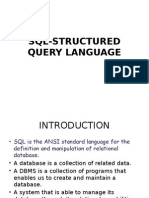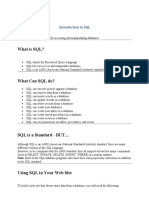0% found this document useful (0 votes)
94 views41 pagesDB Lecture 2 SQL
SQL is a non-procedural language used to manipulate databases. It allows users to create, query, update and delete data from a database. The document outlines key SQL concepts like DDL and DML commands to define and manipulate database objects, operators and clauses to query data, and aggregate functions to perform calculations on data sets. SQL provides powerful capabilities to work with relational databases in an easy to use manner.
Uploaded by
EDWIN RIOBACopyright
© © All Rights Reserved
We take content rights seriously. If you suspect this is your content, claim it here.
Available Formats
Download as PPT, PDF, TXT or read online on Scribd
0% found this document useful (0 votes)
94 views41 pagesDB Lecture 2 SQL
SQL is a non-procedural language used to manipulate databases. It allows users to create, query, update and delete data from a database. The document outlines key SQL concepts like DDL and DML commands to define and manipulate database objects, operators and clauses to query data, and aggregate functions to perform calculations on data sets. SQL provides powerful capabilities to work with relational databases in an easy to use manner.
Uploaded by
EDWIN RIOBACopyright
© © All Rights Reserved
We take content rights seriously. If you suspect this is your content, claim it here.
Available Formats
Download as PPT, PDF, TXT or read online on Scribd
/ 41



























































































